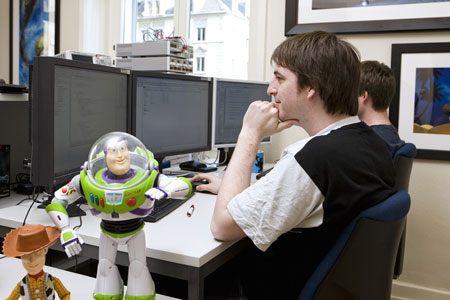The Disney Research Lab Zurich opens its doors for scientists/students/researchers to develop new software procedures and technologies.
“I look back in amazement at the history of computer animation and still find it hard to believe that we could have had such an impact on the entertainment industry. In less than 25 years, computer graphics has grown from the highly experimental work of a few scientists and engineers at a handful of universities, to an art form virtually indispensable to the artistic creation of movies, television series, commercials, and evolving forms of interactive entertainment.”

ETH Zurich is home to one of only two Walt Disney research labs worldwide. The other is at Carnegie Mellon University in Pittsburgh.(Copyright: ETH Zurich/Philippe Hollenstein)
|
Ed Catmull stated those words in 1998, when he was president and cofounder of Pixar Animation Studios. Now, 12 years later, his remarks are even more on target today than they were more than a decade ago.
“This was when our second movie came out, A Bug´s Life. The level of complexity and richness is now way beyond!” says Catmull, who is now president of Walt Disney Animation Studios and Pixar Animation Studios.



Science for Hollywood: Researchers from ETH Zurich, where art meets science on a daily basis. (Copyright: ETH Zurich/Philippe Hollenstein)
|
Having recently received another Academy Award, this time for best animated feature with Up, and only weeks before the long-awaited release of Toy Story 3, Catmull came to Switzerland to officially open the Disney Research lab in Zurich at ETH, the Swiss Federal Institute of Technology.
Once, a century ago, physicist Albert Einstein rushed through those buildings, changing the world with his theory of relativity; at present, the new age of digital wizardry has brought up a novel collaboration between The Walt Disney Company and the leading European university. Collectively, 20 scientists are developing new software procedures and technologies for Disney, along with eight PhD students from ETH and a dozen of affiliated researchers who collaborate with the Disney lab in a project-related capacity.


Pushing the boundaries of possibility, ETH Zurich researchers develop cutting-edge technologies to create increasingly spectacular special effects and make animation as realistic as possible. (Copyright: ETH Zurich/Philippe Hollenstein)
|
Along with the research lab at Carnegie Mellon University (CMU) in Pittsburgh, Disney Research Zurich is one of only two Disney labs located at a university. Since the installation of the CMU lab in 2008, the scientists have already published a dozen scientific papers and even more patents. New cost-effective ways of high-class rendering have been developed as mind-blowing tools to modify stereoscopic material for movies, live-action television, or home entertainment.

Markus Gross, director of Disney Research, has been a professor of computer science at ETH Zurich since 1994 and established the research lab over the past year and a half.
(Copyright: ETH Zurich/Philippe Hollenstein)
|
The handpicked scientists proved that once captured, you still can modify stereo. You even will be able to sit at home and modify the depth of your Blu-ray with your telepilot in real time. Together with Disney Imagineering, the Zurich lab developed new, smart handheld projector systems, which will be used in the Disney theme parks within the Toy Story Mania (Disney’s Hollywood Studios and California Adventure Park) attraction and for the so-called Storyteller Sandbox installation used in a program by D23, the Disney fan community.
Another group works on the ever-increasing demand on face and human modeling. The scientists of Disney Lab Zurich are trying to conquer the Uncanny Valley with a complex 3D scanner, enabling them to reconstruct faces with micrometer precision and, therefore, produce even more realistic 3D face models than ever before. The highly effective scanning device is also able to send the data to an impressive 3D printer.

Bob Sumner, co-director of Disney Research Zurich and head of the Animation and Interactive Graphics group, with a three-dimensional print of a face. (Copyright: ETH Zurich/Philippe Hollenstein)
|
The strategic decision to develop new technologies within The Disney Company is already reaping rewards with stunning results. As Andy Hendrickson, chief technology officer at Walt Disney Animation Studios, states: “It is not always easy to bring the best people to Disney in the US. So we decided to bring Disney to the academic world. Disney is trying to up its presence and raise the bar in the technology and science of entertainment. And to do that, we have started labs all over the world. One of our premier labs is Disney at Zurich, which is raising the bar on Disney´s technology. We are getting great things now, and we expect great things from there in the future.”
Johannes Wolters is a journalist and film critic in Cologne, Germany, who specializes in animation and visual effects.